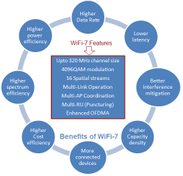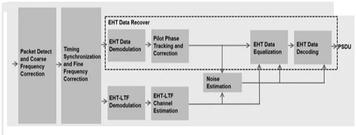WiFi 7 EHT Frame Structure
Advertisement
Under the IEEE 802.11be standard, WiFi 7 introduces the Extremely High Throughput (EHT) frame structure to support its advanced features and capabilities.
WiFi 7 Frame Structure
The EHT frame structure in Wi-Fi 7 builds upon the HE (High Efficiency) frame structure used in Wi-Fi 6 (802.11ax), with enhancements to accommodate the new features introduced by the 802.11be standard. Key components of the WiFi 7 frame structure include the following fields.
1. Preamble
The preamble is crucial for signal synchronization and channel estimation, and it provides the necessary information for the receiver to decode the frame. The EHT preamble has been extended to support new features like wider bandwidths and higher-order modulation.
The preamble in Wi-Fi 7 has been extended to support up to 320 MHz channel bandwidths and includes specific fields to manage multi-link operation and preamble puncturing. The structure includes legacy fields (to ensure backward compatibility) and new fields specific to EHT.
2. EHT-SIG (EHT Signal Field)
This field carries essential information about the frame, such as the modulation and coding scheme (MCS), bandwidth, and spatial configuration. It is an enhancement over the HE-SIG field in WiFi 6 and is divided into several subfields as follows:
EHT-SIG A and SIG-B fields carry detailed signaling information to configure the receiver, including channel width, MCS index, and spatial stream details. The EHT-SIG fields are designed to support dynamic bandwidth allocation, with support for up to 320 MHz bandwidth and up to 16 spatial streams.
- EHT-SIG A: Contains information needed for basic signal decoding, including the bandwidth and number of spatial streams.
- EHT-SIG B: Provides additional details, such as MCS, resource unit allocation for OFDMA, and other operational parameters specific to EHT frames.
3. Data Field
The data field carries the payload (user data) and includes features for enhanced performance.
The data field utilizes advanced encoding schemes to support the higher data rates enabled by 4096-QAM and enhanced aggregation methods. The use of OFDMA and MU-MIMO is optimized through specific signaling within the data field, allowing multiple users to transmit and receive data simultaneously.
- Modulation and Coding Scheme (MCS): Supports up to 4096-QAM, allowing more data bits per symbol and thus higher data rates.
- Aggregation: Enhanced aggregation techniques like A-MPDU (Aggregated MAC Protocol Data Unit) allow multiple data frames to be transmitted together, reducing overhead.
- Pilot Subcarriers: These are used for channel estimation, enabling the receiver to accurately decode the signal despite variations in the wireless channel.
These subcarriers help in maintaining signal fidelity across the transmission by enabling precise channel estimation. This is particularly important for the high-throughput, multi-band operations envisioned in Wi-Fi 7.
- Guard Intervals: Wi-Fi 7 supports shorter guard intervals (e.g., 0.8, 1.6, 3.2 microseconds) to reduce the overhead and increase efficiency, particularly in high-density scenarios.
The guard interval options in Wi-Fi 7 cater to different operational environments, balancing the need for low latency and high throughput against potential interference and multipath effects.
- Trigger-Based Preamble: For multi-user operation in OFDMA, the trigger-based preamble supports coordinated transmissions from multiple stations, optimizing the use of the spectrum.

Wi-Fi 7 PPDU frame fields as shown in the figure are as follows:
- L-STF legacy short training field
- L-LTF legacy long training field
- L-SIG legacy signal field
- RL-SIG repeated legacy signal field
- U-SIG universal signal field
- EHT-SIG EHT signal field
- EHT-STF EHT short training field
- EHT-LTF EHT long training field
- Data Payload
- PE - packet extension field at the end of the frame
There are variations in the repetition of the fields mentioned above as per EHT MU PPDU and EHT TB PPDU formats.
Benefits of EHT Frame Structure in WiFi 7
- Enhanced Throughput: The EHT frame structure supports extremely high data rates due to wider bandwidths (up to 320 MHz), higher modulation (up to 4096-QAM), and improved spatial stream support (up to 16 spatial streams).
- Better Multi-User Efficiency: Enhanced OFDMA and MU-MIMO capabilities within the EHT frame allow simultaneous data transmission to multiple users, significantly improving spectral efficiency and network capacity.
- Lower Latency: The use of shorter guard intervals and optimized aggregation methods reduces the time required for frame transmission, contributing to lower overall latency.
- Improved Spectrum Utilization: Features like preamble puncturing and flexible resource allocation in the EHT-SIG fields allow WiFi 7 to effectively use spectrum even in challenging environments with interference or partial channel availability.
- Support for Advanced Use Cases: The architecture of the EHT frame supports new use cases such as AR/VR, cloud gaming, and real-time applications requiring low latency and high throughput.
Summary : The EHT frame structure of WiFi 7 is a significant advancement designed to meet the growing demands of modern wireless networks.
Advertisement
 RF
RF






